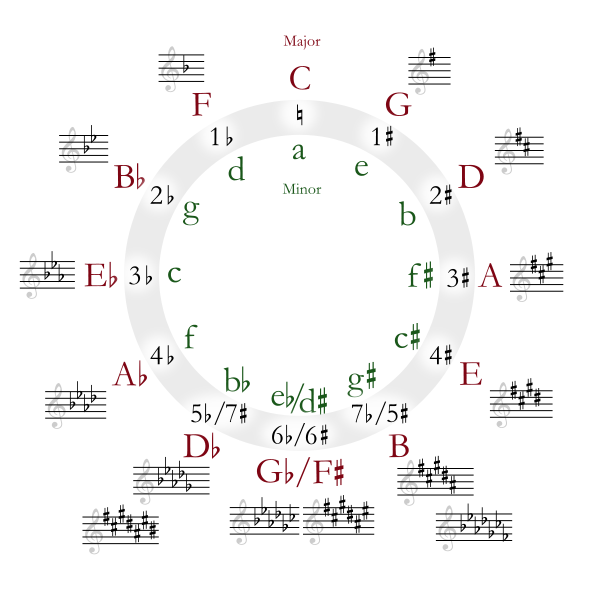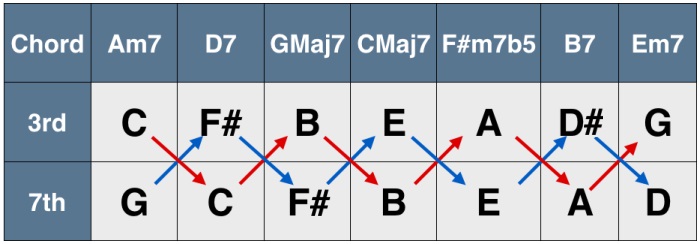Circle of Fifths
The Circle of Fifths (AKA Circle of Fourths) is an important concept in music. It outlines the relationship between each of the 12 notes in the chromatic scale and their related Major and minor keys. The closer two keys are in the Circle of Fifths, the more related they are (i.e. the more notes they share in common).
The Circle of Fifths is called thus because, starting from any note, you can move down in fifths and proceed through all 12 notes until you get back to your original note. Below is a visual depiction of the Circle of Fifths.

The interval of a fifth is significant because it is mathematically the most consonant non-octave interval. But I will leave this for a future lesson on the Overtone Series.
Key Signatures and Modulation
Starting from C Major:
- Moving to the right, each key signature adds a sharp: C, G, D, A, E, B, F#
- Moving to the left, each key signature adds a flat: C, F, B♭, E♭, A♭, D♭, G♭
- The notes on the inside of the circle represent the relative minor of each Major key
The Circle of Fifths can be thought of as the ‘harmonic distance between keys‘.
The Circle of Fifths is useful for a number of reasons:
- It allows you to work out the key signature for every key
- The closer two notes are in the Circle of Fifths, the more ‘related’ they are – that is, the more notes they share in common
- For example, the keys C Major (no sharps) and G Major (one sharp) are closely related
- When songs modulate to a new key, they usually do so to a closely related key (one adjacent in the Circle of Fifths)
- Tonal Chord Progressions VERY often move in fifths (see below)
Circle Progression
The Circle of Fifths can also be thought of as the ‘harmonic distance between chords‘. Two chords derived from the same key and a fifth apart are closely related. This is why chord progressions often move down in fifths. And a chord progression that does this is called a Circle Progression.
A Circle Progression (AKA Diatonic Circle of Fifths) uses only chords from a particular key and moves down in intervals of fifths (although there is on tritone between the 4th and the 7th of the scale just to make it fit diatonically). You can, however, also have a Chromatic Circle of Fifths progression. Both are outlined below, finishing on C Major.
| Circle Progression | |||||||
|---|---|---|---|---|---|---|---|
| Diatonic Circle of Fifths | FMaj7 | Bø7 | Em7 | Am7 | Dm7 | G7 | CMaj7 |
| Chromatic Circle of Fifths (non-resolving ii-V's) | F#Maj7 | B7 | Em7 | A7 | Dm7 | G7 | CMaj7 |
| Chromatic Circle of Fifths (resolving ii-V's) | F#Maj7 - B7 | EMaj7 | Em7 - A7 | DMaj7 | Dm7 - G7 | CMaj7 | CMaj7 |
The reason the Circle Progression sounds so smooth and pleasant is because as you move from one chord to the next:
- One Guide Tone stays the same (Common Tone)
- One Guide Tone move down by a step
As such, this progression creates a strong and smooth Guide Tone Line, which holds the whole chord progression together.

Have a Listen to
- Autumn Leaves
- Fly Me to the Moon
- Blues for Alice
- Confirmation
- All the Things You Are